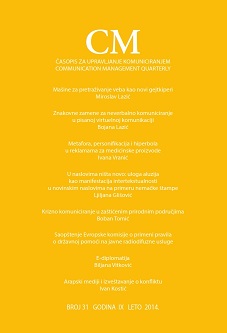Znakovne zamene za neverbalno komuniciranje u pisanoj virtuelnoj komunikaciji
Sign Substitutes for Nonverbal Communication in Written Virtual Communication
Author(s): Bojana LazićSubject(s): Semiology, Philosophy of Language, Theory of Communication, Social Informatics
Published by: Fakultet političkih nauka Univerziteta u Beogradu
Keywords: nonverbal communication; virtual communication; signs of nonverbal communication; emoticons;
Summary/Abstract: With the new way of communicating, online, many changes have emerged making human contact and communication different from what we are used to. One the biggest changes might be the physical absence of the person we are communicating with in cyberspace, which strips away the nonverbal segment of communication when the interaction is limited to only written. “Reading” the nonverbal cues is rather important, since it can point to a proper understanding of the message. Therefore, various substitutes for nonverbal cues are created, such as emoticons, graphical emphasis, acronyms, the use of time etc. In this paper, the author has tried to describe those substitutes, and see to what extent do they have the same functions the nonverbal cues in offline communication do. We were able to see that these signs, although they do enable us to, to a certain point, express our emotions, attitudes, relations between interlocutors, they cannot convey the entire palette of emotions and attitudes nonverbal signs do in real life communication. What is more, they fail to transmit the spontaneous, uncontrolled leakage which “talks” a lot in offline communication. These nonverbal substitutes can also be the clue which addresses the higher level or personal freedom which an individual can experience in online communication, due to the absence of the person to which we’re communicating. On the other hand, the always mediated communication might be used as an opportunity to act violently, with only nonverbal element used.
Journal: CM Komunikacija i mediji
- Issue Year: 9/2014
- Issue No: 31
- Page Range: 23-37
- Page Count: 15
- Language: Serbian

